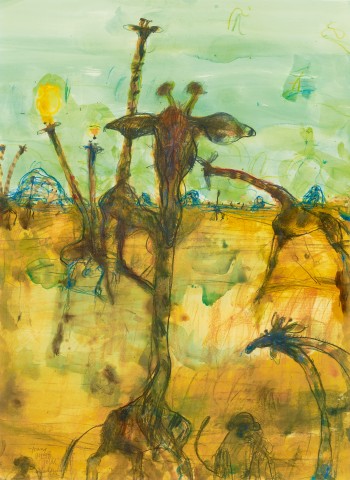YOUNG GIRAFFE
JOHN OLSEN
watercolour and pastel on paper
96.0 x 70.0 cm
signed and inscribed with title lower left: Young / Giraffe / John / Olsen
Maunsell Wickes Gallery, Sydney (label attached verso)
Eva Breuer Art Dealer, Sydney (label attached verso, as ‘Young Giraffes’)
Private collection, Sydney, acquired from the above in 1999
Christie’s, Melbourne, 3 March 2004, lot 4
Private collection, Sydney
‘The urge for life is a staggering thing and we just ought to take notice … There is such fecundity in this universe’.1
Fundamental to his depictions of the natural world is Olsen’s affinity for the myriad fauna that inhabit the landscape; as Deborah Hart observes, ‘perhaps more than any other Australian artist, John Olsen has invested in the animal world in his many drawings, prints, gouaches and watercolours, with a zestful energy and sometimes tender, often humorous insights.’2 Temporarily venturing beyond Australian subjects and influences, Olsen first experienced Africa and its native wildlife in 1978 when he travelled to Kenya and South Africa. With a particular fascination for giraffes and monkeys – ‘the African equivalents of emus and frogs’3 – Olsen perceived in the erratic nature and kinetic energy of these animals, a possibility for exploring a continual somersault of reducing and expanding form and line.
A superb example of Olsen’s explorations during this period, Young Giraffe captures the long-necked, honey-coloured animals in all their elegance – and awkwardness – traversing the barren African plains at the foot of Mount Kenya while a young member of the herd, accompanied by two cheeky monkeys, daringly stares out at the viewer. Olsen famously admired the way in which indigenous depictions of animals conveyed ‘the feeling that the artist is inside and outside the animal – total’4, and thus here, he similarly strives to capture a sense of ‘wholeness’, of the harmonious relationship between the animals and their native habitat. Betraying the artist’s enduring preoccupation with Chinese calligraphy, indeed the animals and landscape are here energetically conveyed by the use of line – thick, thin, smudgy, sharp, rapid and soft – while being simultaneously balanced by the perfect amount of negative space, thus heightening the lightness and playful appeal of the work.
Importantly, as Deborah Hart notes, the aim of such animal studies ‘was not perfection but discovery’ and accordingly, ‘they should not be considered as ends in themselves but as part of the whole web of life that makes up Olsen’s world, and as vital links in his ongoing exploration of the process of drawing.’5 As Olsen himself muses,
‘The act of drawing is closely linked to the fact of an organism; that everything has its own life force and energy. I am really endeavouring to find the satisfactory conclusions to those energies and hence one thing plays against another and I don’t know what is going to happen because the thing has its own life. I know that part of my interest in monkeys and frogs is their crazy ability to articulate limbs in a strange way. It is the exploratory feeling that finally finds an integration that is terribly important…’6
1. Olsen, quoted in Hart, D., John Olsen, Craftsman House, Sydney, 1991, p. 123
2. Hart, ibid., p. 146
3. Ibid.
4. Olsen, J., Salute to Five Bells, Angus and Robertson, Sydney, 1973, n.p.
5. Ibid.
6. Olsen, quoted in Hart, ibid., pp. 146 – 147
VERONICA ANGELATOS
